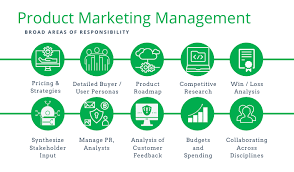Introduction of the Product
In marketing, a product is a tangible good, service, or idea businesses offer to satisfy consumer needs or desires. It is a central component of the marketing mix, including price, place (distribution), and promotion. A well-defined and strategically positioned product is essential for a company’s success in the marketplace.

Here are some key aspects of product marketing:
1. Types of Products
They can be categorized into different types, including consumer goods (products purchased for personal use), industrial goods (products used by businesses for production), services (intangible offerings like banking, healthcare, or consulting), and ideas (such as social or public health campaigns).
2. Product Attributes
Its attributes refer to the characteristics and features that define the product. These can include physical traits, price, design, packaging, brand name, and warranties.
3. Product Life Cycle
Products typically go through a life cycle with four stages: introduction, growth, maturity, and decline. Understanding the product life cycle helps marketers tailor their strategies for each stage.
4. Product Differentiation
Product differentiation involves distinguishing a product from its competitors by highlighting unique features, benefits, or characteristics. This provides a competitive advantage and fosters brand loyalty.
5. Branding
Branding is the process of creating a unique identity and image for a product using a distinctive name, logo, and design. A strong brand can influence consumer perceptions and loyalty.
6. Product Positioning
Product positioning refers to how a product is perceived and placed in the minds of consumers relative to competitors. Effective positioning allows companies to target specific customer segments and address their needs.
7. Product Mix
The product mix, also known as the product portfolio, encompasses the entire range of products offered by a company. It can include a variety of products catering to different markets and customer segments.
8. Product Development
Product development involves creating new products or modifying existing ones to meet changing customer demands and market trends.
9. Product Packaging
Packaging plays a crucial role in product marketing, as it not only protects the product but also communicates brand identity and influences purchasing decisions.
10. Product Distribution
Product distribution focuses on making the product available to customers through various channels, such as retail stores, online platforms, wholesalers, or direct sales.
11. Product Adoption
Product adoption refers to the process by which consumers become aware of a product, try it, and decide to use it regularly. Marketers work to facilitate product adoption to drive sales and customer loyalty.
12. Product Recall and After-Sales Service
In cases of product defects or issues, companies may need to conduct product recalls to ensure customer safety. Additionally, providing excellent after-sales service helps build trust and maintain customer satisfaction.
13. Cross-Selling and Upselling
Successful products can enable cross-selling and upselling opportunities, where customers are encouraged to purchase additional products or premium versions.
14. Long-Term Success
Companies with a strong product portfolio and a focus on continuous improvement are more likely to achieve long-term success and sustainability in the marketplace.
In conclusion, the product is at the core of marketing efforts, and its importance lies in its ability to satisfy customer needs, differentiate the company from competitors, build brand equity, and drive revenue and growth. Understanding the significance of the product enables businesses to develop effective marketing strategies that lead to customer satisfaction, increased market share, and overall business success.

Definition of Product
In marketing, a product is a tangible good, service, or intangible idea that is offered by a company to satisfy the needs, wants, or demands of customers. It is one of the fundamental elements of the marketing mix and forms the basis of any marketing strategy. Here are some definitions of a product in marketing:
1. American Marketing Association (AMA)
According to the AMA, a product is defined as “a bundle of physical, service, and symbolic attributes designed to satisfy a customer’s wants and needs.“
2. Philip Kotler
Philip Kotler, a renowned marketing expert, defines a product as “anything that can be offered to a market for attention, acquisition, use, or consumption that might satisfy a want or need.“
3. Kotler and Armstrong
Kotler and Armstrong further elaborate that a product can include both tangible items, such as physical goods and services, as well as intangible items, like ideas or experiences.
4. Peter Drucker
Peter Drucker, a management consultant, and author, defines a product as “the result of a specific effort, process, or activity. It is not a physical object.“
5. William J. Stanton
In his book “Fundamentals of Marketing,” William J. Stanton defines a product as “a set of tangible and intangible attributes, including packaging, color, price, prestige, retailer’s services, and manufacturer’s services, which the buyer may accept as offering the satisfaction of wants or needs.“
6. Jerome McCarthy
According to Jerome McCarthy, who contributed to the 4Ps marketing mix concept, a product is “a good or service that meets the need or demand of consumers and is offered for exchange through the marketing process.“
Overall, a product in marketing encompasses a wide range of offerings, including physical goods, services, experiences, ideas, and more. It is a vital component in a company’s marketing strategy, and its successful development, positioning, and promotion are essential for meeting customer needs and achieving business goals.



Features of the Product
In the world of advertising, a product’s features embody the wonderful characteristics, attributes, and qualities that define the product, putting it aside from the competition. These capabilities play a vital role in conveying the product’s price proposition to customers and addressing their wishes and desires. Here are the key functions of a product within the context of advertising and marketing:
1. Physical Attributes
For tangible products, bodily attributes encompass length, form, coloration, weight, design, and packaging. These components extensively impact how customers understand and revel in the product.
2. Functionality
A product’s capability refers to its capability to perform the obligations or functions it’s far designed for. A product that correctly fulfills its intended purpose is much more likely to fulfill customer desires.
3. Quality
Quality is a critical feature that impacts customer satisfaction and loyalty. High-nice products are visible as dependable, durable, and excessive-appearing, leaving a fantastic impression on clients.
4. Performance
Performance shows the efficiency and effectiveness of a product in delivering favored results. Products with superior performance tend to gain a competitive edge.
5. Innovative Features
Innovation distinguishes a product from competitors and can create a significant market advantage. Innovative features provide unique benefits and attract customers seeking the latest advancements.
6. Brand Name and Reputation
A sturdy brand name and fantastic recognition beautify the perceived value of the product. Customers can be inclined to pay a premium price for products associated with respectable brands.
7. Customization and Personalization
Providing customization or personalization alternatives permits customers to tailor the product to their specific possibilities, increasing its enchantment.
8. User-Friendly Design
User-friendly products are easy to understand, perform, and preserve. A straightforward design enhances the customer experience and reduces barriers to adoption.
9. Warranties and Guarantees
Offering warranties or guarantees instills confidence in the product’s quality and reliability, providing customers with peace of mind.
10. Safety Features
Safety features are crucial for products that pose potential risks to consumers. Clear safety measures build trust and credibility.
11. Environmental Sustainability
In today’s eco-conscious market, products with environmentally friendly features are increasingly attractive to environmentally aware consumers.
12. Price
While price is part of the marketing mix, it can also be considered a product feature. Pricing features, such as discounts, payment options, and financing, can influence purchase decisions.
13. After-Sales Service
Offering excellent after-sales services, such as customer support, installation assistance, or maintenance, enhances customer satisfaction and encourages repeat business.
14. Compatibility and Interoperability
Products that are compatible with other devices or systems provide greater convenience and expand their usability.
15. Emotional Appeal
Some products possess emotional features that resonate with customers’ desires, aspirations, or emotions, making them more attractive on an emotional level.
A successful advertising approach involves effectively highlighting those product capabilities through numerous advertising channels, which include advertising, packaging, and promotional campaigns. Understanding and leveraging those capabilities can help organizations function their merchandise effectively, construct a strong brand image, and meet the wishes and expectations of their target clients.

Importance of the Product
It is a critical element in advertising, and its importance can’t be overstated. It serves as the muse of a business enterprise’s advertising and marketing efforts and plays a good role in achieving commercial enterprise targets and pleasing client wishes. Here are the important reasons why they holds brilliant importance in advertising:
1. Customer Satisfaction
A nicely designed and superb product is essential for customer pleasure. Meeting or exceeding customer expectations with the product ends in better stages of customer loyalty and high-quality word-of-mouth, which can be precious for lengthy-term success.
2. Competitive Advantage
Unique product functions, progressive designs, and superior satisfaction can create an aggressive gain within the marketplace. A differentiated product sticks out from the competition, enabling the enterprise to capture a larger marketplace percentage.
3. Brand Building
The product is an essential component of brand building. Customers partner the product with the business enterprise’s brand, and an advantageous product contributes to brand loyalty and brand equity.
4. Customer Needs and Wants
Successful products are designed to address specific customer needs and desires. Understanding customer preferences and pain points allows companies to tailor their products to the target market.
5. Value Proposition
The product’s features and benefits form the core of the value proposition, communicating the unique value it offers to customers. A compelling value proposition attracts customers and drives purchase decisions.
6. Market Positioning
The product plays a crucial role in market positioning. Companies position their products to occupy a distinct place in the minds of customers based on unique features, quality, or price points.
7. Revenue Generation
Products generate revenue for the company. A powerful product approach can cause multiplied income, higher profit margins, and improved economic performance.
8. Innovation and Growth
Developing new and revolutionary products permits businesses to adapt to changing market traits and customer demands. Continuous product innovation drives growth and keeps the business relevant.
9. Customer Loyalty
A great product creates satisfied and loyal customers, reducing the likelihood of customers switching to competitors. Devoted customers are inclined to make repeat purchases and advocate for the product to others.
10. Market Entry and Expansion
When entering a new market or expanding to new customer segments, a strong product offering is essential for gaining acceptance and traction in the market.
11. Differentiation from Competitors
In a crowded marketplace, a product can differentiate a company from competitors. A unique selling proposition (USP) based on product features can attract customers who seek specific benefits.
12. Cross-Selling and Upselling
Successful merchandise can facilitate pass-selling and upselling opportunities, where clients are encouraged to purchase additional merchandise or top-rate variations.
13. Long-Term Success
Companies with a strong product portfolio and a focus on continuous improvement are more likely to obtain long-term success and sustainability in the market.
In conclusion, the product is at the center of marketing efforts, and its significance lies in its ability to fulfill customer needs, differentiate the organization from competition, construct brand equity, and force revenue to increase. Understanding the significance of the product helps corporations broaden effective marketing techniques that result in consumer satisfaction, increased marketplace percentage, and normal enterprise success.

Advantages of the Product
The product stands as a central pillar in marketing, offering a plethora of advantages that contribute significantly to a company’s marketing efforts. Here are some pivotal benefits of the product within the realm of marketing:
1. Enhanced Customer Satisfaction
A meticulously designed, high-quality product fulfills customer needs and surpasses expectations, leading to elevated levels of customer satisfaction. Content customers are more likely to become repeat purchasers and enthusiastic brand advocates, thereby boosting the company’s reputation and sales.
2. Competitive Edge
Unique product features, innovations, and superior quality can carve out a competitive advantage in the market. A distinct product sets the company apart from rivals and magnetizes a larger customer base.
3. Foundation for Brand Building
The product serves as a cornerstone in brand building. A successful product, coupled with positive customer experiences, contributes profoundly to building a robust brand image and fostering brand loyalty.
4. Effective Market Positioning
The product’s features and benefits act as the foundation for its market positioning. Effective product positioning allows the company to target specific customer segments and communicate the product’s value proposition with precision.
5. Cultivation of Customer Loyalty
A stellar product cultivates customer loyalty and repeat business. Loyal customers are more likely to make repurchases and recommend the product to others, creating a steady revenue stream.
6. Revenue Amplification
Products represent a significant revenue source for the company. Successful products with high demand tend to increase sales and improve profit margins.
7. Encouragement of Innovation and Growth
Continuous product innovation and enhancements empower companies to stay relevant in a dynamic market environment, fostering business growth.
8. Elevation of Brand Equity
A well-received product elevates brand equity, signifying the overall value and perception of the brand in the minds of consumers. Positive brand equity can drive increased customer loyalty and willingness to pay premium prices.
9. Customer Retention
Offering a product that consistently meets customer expectations bolsters customer retention. Retaining current clients proves to be more cost-effective than acquiring new ones, leading to enduring customer relationships in the long term.
10. Cross-Selling and Upselling Opportunities
Successful products create possibilities for cross-selling and upselling, in which customers are urged to buy extra products or improve to higher-value variations.
11. Facilitation of Market Entry and Expansion
A robust product offering is a critical factor for successfully entering new markets or expanding to new customer segments.
12. Differentiation from Competitors
A distinctive product offering differentiates the company from competitors, helping capture the attention and preference of specific customer groups.
13. Long-Term Viability
A well-rounded product portfolio and a commitment to continuous development contribute to the corporation’s long-term fulfillment and sustainability in the market.
14. Positive Word-of-Mouth
Satisfied customers are more likely to share their effective experiences with others, leading to favorable word-of-mouth advertising and natural brand merchandising.
In summary, the advantages of the product in marketing are vast and potent. A meticulously conceived and strategically positioned product can profoundly impact customer satisfaction, brand equity, market positioning, and overall business success. Companies that prioritize product development and continuously strive to meet customer needs are better equipped to thrive in the competitive marketplace.

Disadvantages of the Product
While the product is a critical component in marketing and offers numerous advantages, there are also some potential disadvantages associated with product-related aspects of marketing. These disadvantages can impact a company’s marketing efforts and overall business performance. Here are some key disadvantages of the product in marketing:
1. Product Obsolescence
In fast-changing markets, products can quickly become obsolete due to technological advancements or changing customer preferences. Companies must continuously innovate and update their products to remain competitive.
2. High Development Costs
Developing new products or improving existing ones can be costly, especially for complex and technologically advanced offerings. High development costs can affect a company’s profitability and return on investment.
3. Quality Issues
If a product does not meet quality standards or experiences manufacturing defects, it can result in customer dissatisfaction, negative reviews, and potential legal liabilities.
4. Market Saturation
In some markets, saturation occurs when multiple companies offer similar products, leading to intense competition and price pressure. It becomes challenging to differentiate the product from its competitors.
5. Short Product Life Cycle
Some products have a short life cycle due to rapidly changing trends or seasonal demand. Managing products with short life cycles requires efficient inventory management and marketing strategies.
6. Demand Variability
Demand for certain products can be highly variable, leading to challenges in production planning and inventory management.
7. High Inventory Costs
Maintaining inventory can be expensive, especially for products with slow turnover rates or perishable goods that require careful handling and storage.
8. Negative Publicity
If a product faces recalls, protection concerns, or ethical problems, it may result in negative exposure and damage the brand’s reputation.
9. Lack of Customer Interest
Even with a nicely designed product, there can be a loss of customer interest because of useless marketing or misalignment with consumer desires and preferences.
10. Cannibalization
The advent of the latest products can lead to cannibalization, wherein sales of current products decline as clients transfer to newer services.
11. Overextension of Product Line
Expanding the product line without proper market research can lead to an overextended product portfolio, making it difficult for customers to identify the core product or confusing.
12. High Entry Barriers
Developing certain products may require specialized skills, technology, or regulatory approvals, making entry into the market challenging for new entrants.
13. Cost of Product Differentiation
Creating unique features and product differentiators can be costly, impacting pricing and profitability.
13. Warranty and After-Sales Service Costs
Offering warranties and after-sales service can incur extra fees for the corporation.
Businesses must be aware of these dangers and deal with them successfully through product development, advertising and marketing techniques, and consumer-centered projects. Proper marketplace studies, customer feedback, and non-stop development can help mitigate capability dangers and enhance the overall success of the product in the marketplace.




[…] Product success stories serve as powerful narratives that showcase how innovative ideas, strategic marketing, and customer-centric approaches can transform products into household names or industry leaders. These stories provide valuable insights into the journey of products from conception to market success, highlighting the challenges faced, strategies implemented, and milestones achieved. […]
[…] brand perception, and heightened consumer engagement. The campaign reignited enthusiasm for a product that had been on the market for over a century, demonstrating the power of emotional connection and […]